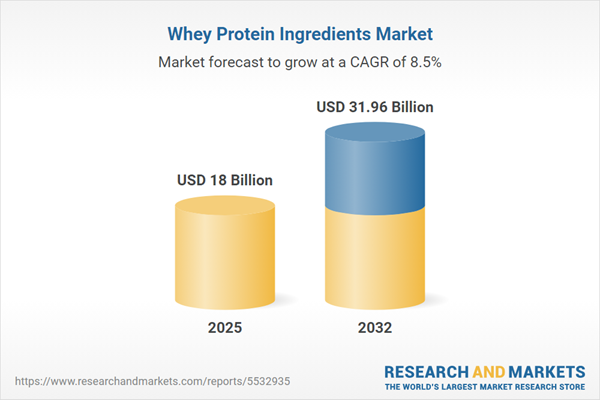Speak directly to the analyst to clarify any post sales queries you may have.
The whey protein ingredients market is undergoing significant change as global health preferences evolve, sustainability demands intensify, and regulatory frameworks advance. Senior decision-makers face increasing urgency to adapt strategy, operational models, and compliance practices to secure competitive advantage in this rapidly shifting sector.
Market Snapshot: Key Drivers and Trends in the Whey Protein Ingredients Market
Demonstrating consistent growth, the whey protein ingredients market is shaped by strong ongoing demand from sports nutrition, functional foods, and wellness-oriented product categories. Companies are innovating by enhancing nutritional value, minimizing additives, and launching products responsive to clean-label and transparency demands. The focus on sustainability has brought tangible changes across the sourcing, production, and logistics ecosystem. This has driven manufacturers and suppliers to engage in more robust environmental management throughout the supply chain. Varying regulations across Americas, EMEA, and Asia-Pacific regions are compelling organizations to design flexible, adaptive go-to-market strategies. A deep emphasis on resilience enables companies to stay ahead in this evolving marketplace.
Scope & Segmentation
- Ingredient Types: Comprising whey protein concentrate, hydrolysate, and isolate, this diversity enables precise targeting for nutritional and industrial uses, reflecting high formulation flexibility for product teams.
- Product Forms: Encompassing powders, protein bars, and ready-to-drink liquids, organizations can address both mass-market needs and specialized performance niches as portfolios diversify.
- Applications: Includes animal feed, human nutrition supplements, dairy and bakery items, functional beverages, and personal care—showcasing the broad cross-industry adoption and opportunity for innovation.
- Distribution Channels: Accessible via retail pharmacies, specialty retailers, supermarkets, hypermarkets, e-commerce platforms, and direct-to-consumer pathways, enabling agility and expanded customer reach for market participants.
- Covered Regions: Commercial environments in Americas, EMEA, and Asia-Pacific shape market entry tactics. Local regulatory and cultural variations require tailored expertise and integrated global operations for optimal results.
- Key Companies: Industry direction is influenced by Glanbia Plc, Lactalis Group, Fonterra Co-operative Group Limited, Arla Foods amba, Royal FrieslandCampina N.V., Saputo Inc., Hilmar Cheese Company, Inc., Davisco Foods International, Inc., Volac International Ltd, and Savencia Fromage & Dairy S.A.S., all centering their strategies on compliance, innovation, and responsible supply chain management.
Key Takeaways for Senior Decision-Makers
- Expand product portfolios with clean-label, high-protein variants to meet rising consumer expectations for nutritional transparency and wellness-driven offerings.
- Leverage advanced ingredient innovations to capture both mature and emerging segment opportunities, as demand broadens beyond sports nutrition into personal care and functional foods.
- Embed digital technologies such as blockchain for end-to-end supply chain traceability, optimizing compliance, partner engagement, and process visibility throughout complex distribution networks.
- Promote sustainable growth by refining procurement, minimizing waste, and investing in environmentally conscious production methods to address evolving stakeholder expectations.
- Cultivate local partnerships and adjust operational tactics to navigate region-specific regulations, reducing exposure to compliance risks while sustaining supply chain continuity.
- Reinforce omnichannel distribution, incorporating rapid adjustments to consumer purchasing patterns and maximizing penetration across varying customer segments.
Tariff Impact: Navigating U.S. Supply Chain and Cost Pressures
Shifting U.S. tariff policies introduce added complexity to the whey protein ingredients supply chain. To address these pressures, companies are investing in domestic suppliers and diversifying sourcing networks, mitigating risk and supporting uninterrupted delivery. Strategic product reformulation and supplier expansion help achieve compliance and support cost management in an environment of increased regulatory scrutiny.
Methodology & Data Sources
This assessment applies comprehensive secondary research, regulatory analysis, patent review, and direct interviews with industry executives. Utilizing advanced analytics, the analysis delivers robust segmentation and actionable strategic insights to guide senior leaders as industry dynamics evolve.
Why This Report Matters for Market Leadership
- Enables leaders to proactively address sustainability and compliance trends, supporting organizational agility in a variable regulatory and market environment.
- Supports optimized operational resource allocation, empowering businesses to navigate cost, compliance, and supply chain challenges efficiently.
- Delivers actionable intelligence for planning and prioritization, strengthening global competitiveness amid ongoing market transformation.
Conclusion
Executives gain the strategic foundation to drive innovation, enhance operational resilience, and secure growth as the whey protein ingredients market continues to evolve. This report equips decision-makers to lead confidently in a complex landscape.
Additional Product Information:
- Purchase of this report includes 1 year online access with quarterly updates.
- This report can be updated on request. Please contact our Customer Experience team using the Ask a Question widget on our website.
Table of Contents
3. Executive Summary
4. Market Overview
7. Cumulative Impact of Artificial Intelligence 2025
Companies Mentioned
The companies profiled in this Whey Protein Ingredients market report include:- Glanbia Plc
- Lactalis Group
- Fonterra Co-operative Group Limited
- Arla Foods amba
- Royal FrieslandCampina N.V.
- Saputo Inc.
- Hilmar Cheese Company, Inc.
- Davisco Foods International, Inc.
- Volac International Ltd
- Savencia Fromage & Dairy S.A.S.
Table Information
| Report Attribute | Details |
|---|---|
| No. of Pages | 195 |
| Published | October 2025 |
| Forecast Period | 2025 - 2032 |
| Estimated Market Value ( USD | $ 18 Billion |
| Forecasted Market Value ( USD | $ 31.96 Billion |
| Compound Annual Growth Rate | 8.5% |
| Regions Covered | Global |
| No. of Companies Mentioned | 11 |









